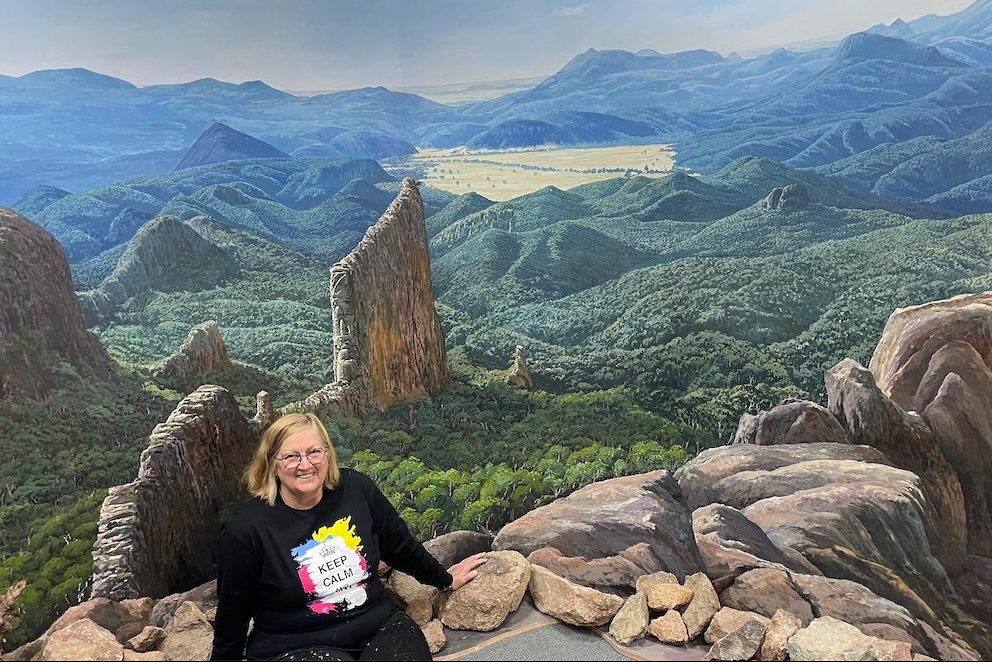
A CANBERRA artist more accustomed to refurbishing other people’s old artworks, has used her skills on one of her own 37-year-old paintings – and she’s sold it.
Margaret Hadfield, founder-owner of the Artists Shed in Fyshwick, is best known as the inaugural winner of the Gallipoli Art Prize in 2006, but has just returned from a road trip to her hometown, Coonabarabran, transporting a large mural to the Crystal Kingdom Museum, a specialty venue that displays minerals and fossils from the region.
It was in every way a homecoming journey for the large landscape impression of the “Breadknife” formation in the Grand High Tops of Warrumbungle National Park, which was purchased from Hadfield by the museum for the sum of $15,000.
Although Hadfield left the region for Canberra 33 years ago she has grandchildren there, and when she visits it brings lots of memories, most of the family theme park Miniland, started by her Dutch immigrant artist father, Peter Zorgdrager.
The work was originally painted 37 years ago, shortly after her father’s death when she, her then husband and mother took over management of Miniland, a quirky tourist attraction famous for its maze of dinosaurs made from steel, chicken wire and fibreglass.
Created over a period of six months to fill an empty space, Hadfield says, the idea was to let people see the “Breadknife” which was in a remote and partly inaccessible place.
“You can easily get there if you’re fit, but you have to walk uphill, so my thought was to show it to people who can’t do that,” she says.
“It was done in a half circle to create some magic and I put my heart and soul into it.”
Unlike Michelangelo, Hadfield didn’t have a team of assistants and painted it by herself while running the park and bringing up a family.

Her painting became an attraction in its own right, but the park was abandoned many years ago.
Miniland’s famous brontosaurus (the theme park used to sell “brontosaurus steak sandwiches”) melted during savage bushfires, while the triceratops and Tyrannosaurus rex were passed on to other parks and other items were sold off.
But over a long period of time, she’d been wondering what happened to the mural and reached out to an old Coonabarabran school friend, who located it in a shed in the Warrumbungle National Park.
“They were more than happy to hand it back,” Hadfield says.
“But it was in a pretty bad way, it had white ants, and it was in five pieces… but I really value old art and restored some work by artists like Judy McConachie when I came to Canberra.”
With the help of her swimming coach, Les Worthington, it was backed, repaired and installed in the Fyshwick premises and she even added in a few real rocks in the foreground to give it veracity.
Then her school friend suggested putting it on Facebook. Six inquiries came within hours, followed by a firm offer in two days.
Worthington helped her dismantle it, get it on to a truck and re-install it in Coonabarabran, where it’s already creating a mini media storm as far afield as Dubbo.
As for Hadfield: “I’m really happy to have it back in Coonabarabran where it started,” she says.
Who can be trusted?
In a world of spin and confusion, there’s never been a more important time to support independent journalism in Canberra.
If you trust our work online and want to enforce the power of independent voices, I invite you to make a small contribution.
Every dollar of support is invested back into our journalism to help keep citynews.com.au strong and free.
Thank you,
Ian Meikle, editor




Leave a Reply